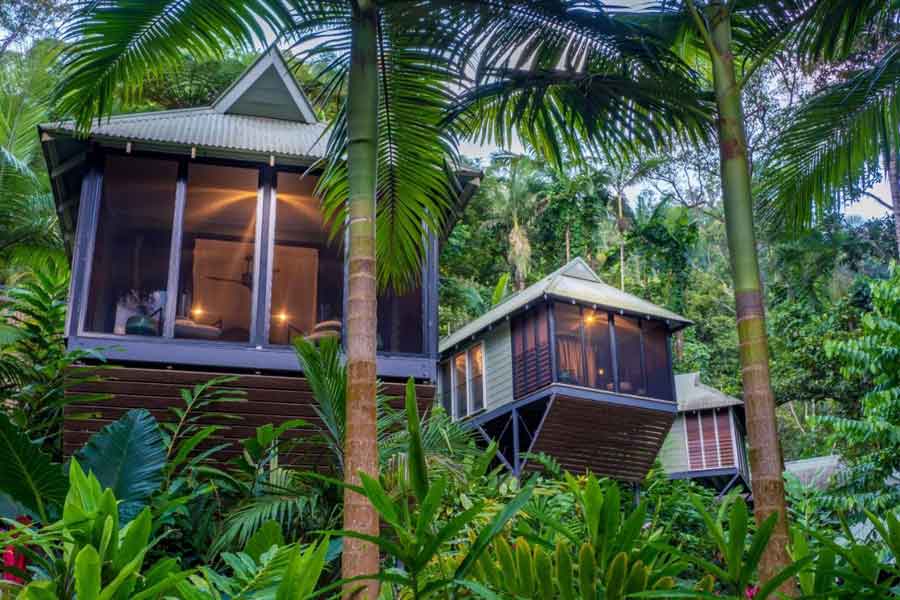Australian eco-lodges represent a transformative approach to travel, where luxury and sustainability intersect amid the continent’s most breathtaking natural landscapes. From the ancient canopies of the Daintree Rainforest to the rugged red expanses of the Outback and the crystal-blue coastlines of the Coral Sea, these unique accommodations allow travelers to connect with nature without harming it. Unlike traditional hotels, eco-lodges are built with minimal environmental impact and often serve as active participants in conservation, education, and community empowerment. Properties like Daintree Wilderness Lodge and Silky Oaks Lodge are renowned for using solar energy, sustainable architecture, and eco-certified operations to preserve their surrounding ecosystems.
In the vast and remote heart of Australia, eco-lodges like Longitude 131° exemplify the marriage of outback luxury and responsible tourism. These lodges not only provide unforgettable views of Uluru but also collaborate with Indigenous communities to offer culturally enriching experiences. According to Tourism Australia, over 60% of eco-accommodation in the Outback incorporates Aboriginal storytelling and local guides, ensuring that travelers gain insight into the land’s deep spiritual and historical significance. Meanwhile, technologies such as greywater systems, solar arrays, and composting toilets have allowed some desert-based lodges to reduce their water usage by up to 50% and energy consumption by 40%.
Along Australia’s stunning coastline, beachfront eco-lodges like Sal Salis Ningaloo Reef and Lady Elliot Island Eco Resort offer low-impact lodging that safeguards fragile marine habitats. These retreats work in tandem with organizations like the Great Barrier Reef Marine Park Authority, engaging guests in reef monitoring programs and encouraging reef-safe practices like biodegradable toiletries and sunscreen. At Sal Salis, off-grid living isn’t a sacrifice but a feature — the lodge is fully powered by solar panels and built behind primary dunes to avoid coastal erosion, embodying eco-conscious design.
Wildlife-focused lodges add another layer of immersion. Properties like Arkaba Conservancy and Binna Burra Lodge give travelers rare opportunities to observe endangered species in their natural habitats while directly supporting conservation projects. Arkaba, a 60,000-acre private reserve, has seen a 30% increase in native wildlife populations since eliminating livestock and focusing on ecological restoration. Visitors can join guided safaris led by ecologists or participate in citizen science programs, collecting data that contribute to national biodiversity databases. These experiences turn a simple holiday into an act of environmental stewardship.
For travelers seeking comfort with a conscience, Australian eco-lodges deliver more than just a place to sleep — they offer an invitation to rethink the way we experience nature. Backed by trusted certifications from Ecotourism Australia, these lodges meet stringent environmental and ethical standards. Whether nestled in the treetops, perched on a desert ridge, or resting near a coral reef, eco-lodges across Australia redefine travel as a force for good — luxurious, yes, but also low-impact, educational, and deeply rooted in the ecosystems they protect.
Hidden Havens in the Rainforest
Immersed in Nature’s Embrace
Nestled deep in Australia’s tropical rainforests, eco-lodges such as Daintree Wilderness Lodge and Silky Oaks Lodge offer immersive stays where biodiversity thrives. The Daintree Rainforest alone is home to over 3,000 plant species and 430 bird species, making it one of the world’s oldest and richest ecosystems.
Built to Preserve, Not to Dominate
These lodges are constructed with minimal environmental impact. Elevated boardwalks, solar energy, and rainwater harvesting are common features. Silky Oaks Lodge, for example, uses 100% solar power for all guest accommodations and facilities.
Supporting Local Communities
Australian eco-lodges in rainforest areas frequently source products and services from nearby communities. A study by Ecotourism Australia showed that 78% of eco-lodges in Queensland invest in local employment and training, helping sustain both economy and ecology.
Wildlife Encounters at Your Doorstep
Guests often wake up to the calls of the endangered cassowary or spot tree kangaroos while sipping morning tea. The proximity of these lodges to protected areas ensures natural wildlife interactions without disturbing their habitats.
Tourism with a Purpose
In 2023, Australia recorded over 9 million ecotourism visitors, with rainforest eco-lodges drawing a significant share due to their conservation-driven mission. Choosing Australian eco-lodges helps travelers reduce their carbon footprint while directly supporting conservation projects.
Sustainable Luxury in the Outback
Comfort Meets Conservation
In the vast red landscapes of the Australian Outback, luxury meets sustainability at eco-lodges like Longitude 131° near Uluru and Bamurru Plains in the Northern Territory. Despite their luxury, these lodges adhere to strict environmental codes and offset 100% of their carbon emissions.
Architectural Harmony with the Land
Structures are built to blend into the desert terrain using materials like recycled timber and insulated canvas. At Longitude 131°, raised platforms ensure zero ground impact, and buildings are strategically placed to reduce energy use by up to 40%.
Indigenous Culture and Connection
Many Outback eco-lodges partner with Aboriginal communities. Guests at Kings Creek Station participate in cultural tours guided by local Anangu elders. According to Tourism NT, over 60% of Outback eco-lodges include Indigenous-led experiences.
Minimal Water Footprint
With annual rainfall under 300mm in some regions, water-saving technologies are crucial. Composting toilets, greywater recycling, and drought-tolerant landscaping are widely adopted, reducing lodge water usage by 35-50% compared to standard accommodations.
Remote Yet Responsible
Australian eco-lodges in the Outback allow access to remote wilderness without compromising on comfort or conscience. Their operations serve as a model for sustainable tourism in arid ecosystems, showcasing a responsible way to explore Australia’s heartland.
Beachside Retreats with a Green Heart
Eco-Conscious Oceanfront Living
From Byron Bay to Western Australia’s Ningaloo Reef, beachfront eco-lodges offer serene escapes while actively protecting marine ecosystems. At Sal Salis Ningaloo Reef, accommodations are built behind the primary dune line, preserving native flora and preventing erosion.
Harnessing Sun and Wind
Australian eco-lodges along the coast typically rely on renewable energy. Sal Salis operates 100% off-grid, powered entirely by solar energy, while other lodges utilize wind turbines and battery storage to remain sustainable even during high occupancy.
Marine Protection Partnerships
Eco-lodges often partner with marine conservation groups. Guests at Lady Elliot Island Eco Resort, for instance, contribute to reef monitoring projects coordinated with the Great Barrier Reef Marine Park Authority, which protects over 344,400 square kilometers of ocean.
Low-Impact Activities
Guests engage in snorkeling, kayaking, and reef walks that are carefully regulated to minimize environmental impact. According to Ecotourism Australia, 72% of marine eco-lodges implement strict visitor codes to protect fragile coastal ecosystems.
Eco-Fashion and Local Dining
Sustainability extends to guest experiences, with local, organic cuisine and eco-friendly amenities. Some lodges have reduced plastic usage by over 80% and promote reef-safe sunscreen and biodegradable toiletries to protect marine life.
Eco-Friendly Escapes for Wildlife Lovers
Living Among the Creatures
Wildlife-focused Australian eco-lodges offer front-row seats to native animal encounters. At Arkaba Conservancy in South Australia, visitors share space with over 5,000 reintroduced native species, including the western quoll and yellow-footed rock wallaby.
Conservation at the Core
These lodges often serve as private reserves. Arkaba manages 60,000 acres of rehabilitated land, free of livestock, with a focus on predator control and habitat restoration. Such efforts have contributed to a 30% rise in native mammal sightings since 2020.
Guided by Biologists
Guests enjoy educational safaris led by ecologists. At Binna Burra Lodge in Queensland, wildlife walks led by scientists give insight into species recovery programs. Over 85% of eco-lodges employ conservation-trained guides.
Nocturnal Adventures
Eco-lodges like Yaraandoo in New South Wales offer night-time safaris, giving guests a chance to witness rare nocturnal species like sugar gliders and owls, with observation points designed to avoid light pollution and disturbance.
Citizen Science Participation
Some Australian eco-lodges allow guests to join wildlife tracking programs. In a 2022 study, 22% of guests at selected lodges participated in data collection for university-led fauna surveys, turning tourism into hands-on conservation.




